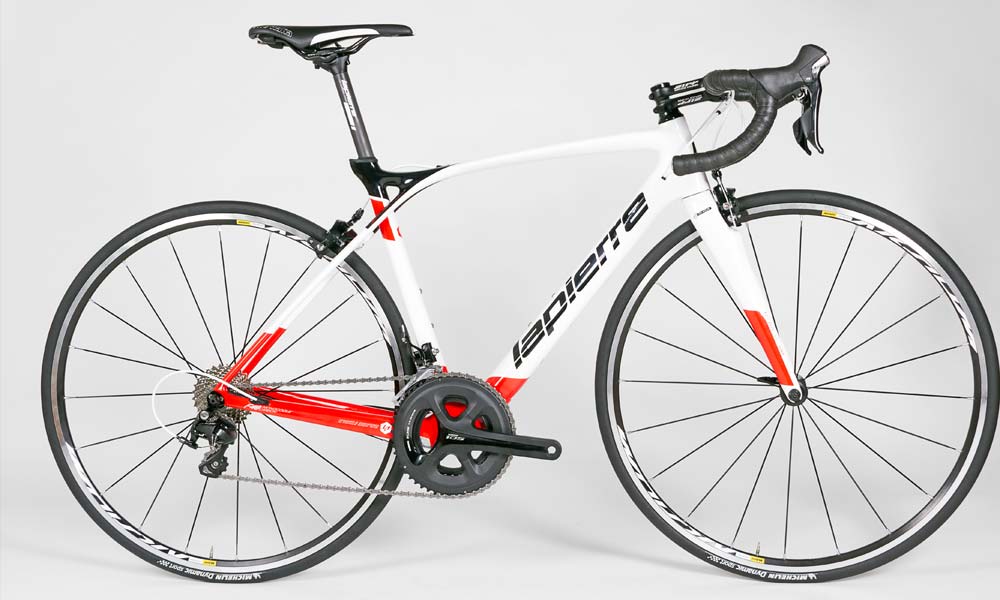[et_pb_section bb_built=”1″ admin_label=”section”][et_pb_row admin_label=”row”][et_pb_column type=”1_4″][et_pb_text admin_label=”Text” background_layout=”light” text_orientation=”left” use_border_color=”off” border_color=”#ffffff” border_style=”solid”]
Great frame, considered ride qualities, clever spec… good price. There is much to like about the Lapierre Xelius.
[/et_pb_text][/et_pb_column][et_pb_column type=”3_4″][et_pb_text admin_label=”Text” background_layout=”light” text_orientation=”left” use_border_color=”off” border_color=”#ffffff” border_style=”solid”]
Review introduction
My advice has been sought over the years by various friends (and extensions of friends) on what they should buy as relative ‘beginners’. My often-ignored advice is to either spend $3,000-$4,000 on something they can cherish for several years, or buy an entry-level road bike as a ‘test run’ to see if they take to the notion of ‘being a roadie’.
Few people look at the quality of the frame when buying a new bike and categorise brands as ‘cheap’ or ‘expensive’ based on frame composition, the groupset and the price.
If everyone used this model for buying, the Lapierre Xelius SL 500 would be, incorrectly, labelled a ‘carbon rip-off’, something not worth considering. Foolhardy shoppers would offer such an appraisal after a cursory glance missed all the benefits of the Xelius SL 500. Don’t be like that! This Shimano 105-clad beauty is a wolf in sheep’s clothing which needs a careful inspection before being dismissed.
– Read the full review as it appeared in the magazine –
[/et_pb_text][/et_pb_column][/et_pb_row][et_pb_row admin_label=”Row”][et_pb_column type=”4_4″][et_pb_image admin_label=”Image” show_in_lightbox=”off” url_new_window=”on” use_overlay=”off” animation=”off” sticky=”off” align=”center” force_fullwidth=”off” always_center_on_mobile=”on” use_border_color=”off” border_color=”#ffffff” border_style=”solid” src=”https://www.ridemedia.com.au/wp-content/uploads/2017/12/Lapierre_Xelius_72-Top.jpg” url=”https://indd.adobe.com/view/dc0407a4-1368-4ca4-b6a4-b85e3c180591″ /][/et_pb_column][/et_pb_row][et_pb_row admin_label=”Row”][et_pb_column type=”1_4″][et_pb_text admin_label=”Text” background_layout=”light” text_orientation=”left” use_border_color=”off” border_color=”#ffffff” border_style=”solid”]
Click the image above to read the full review of the Lapierre Xelius.
[/et_pb_text][/et_pb_column][et_pb_column type=”3_4″][et_pb_text admin_label=”Text” background_layout=”light” text_orientation=”left” use_border_color=”off” border_color=”#ffffff” border_style=”solid”]
Build report introduction
Whether it is a Dura-Ace equipped Aircode or this masterfully designed 105 equipped Xelius SL, bikes from Lapierre are always a pleasure to build. They are aesthetically pleasing on a workstand and are functionally straightforward.
Routing four wire cables is a rarity in this age of hydraulic discs and electronic shifting but building this bike served as a reminder that mechanical shifting is not a bad thing. And this comment isn’t based around the high-end product line either – it’s 105, not Dura-Ace.
The installation process for Shimano’s third-tier ensemble is identical to Ultegra and Dura-Ace, so building the Xelius SL was simple.
– Read the full review as it appeared in the magazine –
[/et_pb_text][/et_pb_column][/et_pb_row][et_pb_row admin_label=”Row”][et_pb_column type=”4_4″][et_pb_image admin_label=”Image” show_in_lightbox=”off” url_new_window=”on” use_overlay=”off” animation=”off” sticky=”off” align=”left” force_fullwidth=”off” always_center_on_mobile=”on” use_border_color=”off” border_color=”#ffffff” border_style=”solid” src=”https://www.ridemedia.com.au/wp-content/uploads/2017/12/Lapierre-DSC06781.jpg” url=”https://indd.adobe.com/view/dc0407a4-1368-4ca4-b6a4-b85e3c180591″ /][/et_pb_column][/et_pb_row][et_pb_row admin_label=”Row”][et_pb_column type=”1_4″][et_pb_text admin_label=”Text” background_layout=”light” text_orientation=”left” use_border_color=”off” border_color=”#ffffff” border_style=”solid”]
Lapierre makes a strong case for the resurgence of white, red and black colour schemes. Its lines are laser-straight and the red has a bit of orange to it, making it more interesting than other shades of rouge.
[/et_pb_text][/et_pb_column][et_pb_column type=”3_4″][et_pb_text admin_label=”Text” background_layout=”light” text_orientation=”left” use_border_color=”off” border_color=”#ffffff” border_style=”solid”]
A total of 392 bikes were reviewed by RIDE Media from 1998 to 2017.
This bike was reviewed in #RIDE71, published in March 2016. To read the complete article, click the link of the images above to see it as it appeared in the magazine, complete with the full review, complete spec sheet, weights of all components and, of course, the ‘Build Report’.
We will be publishing some of the complete tests as PDFs on our Adobe page. If there is one bike in particular you would like to see, send an email request.
[/et_pb_text][/et_pb_column][/et_pb_row][et_pb_row admin_label=”Row”][et_pb_column type=”4_4″][et_pb_image admin_label=”Image” show_in_lightbox=”off” url_new_window=”off” use_overlay=”off” animation=”off” sticky=”off” align=”left” force_fullwidth=”off” always_center_on_mobile=”on” use_border_color=”off” border_color=”#ffffff” border_style=”solid” src=”https://www.ridemedia.com.au/wp-content/uploads/2017/12/Lapierre_Xelius_72-Jig.jpg” url=”https://indd.adobe.com/view/dc0407a4-1368-4ca4-b6a4-b85e3c180591″ /][/et_pb_column][/et_pb_row][/et_pb_section]



